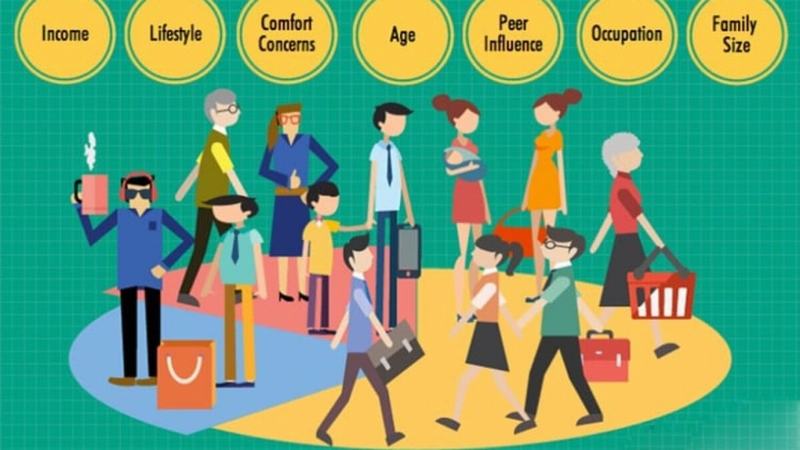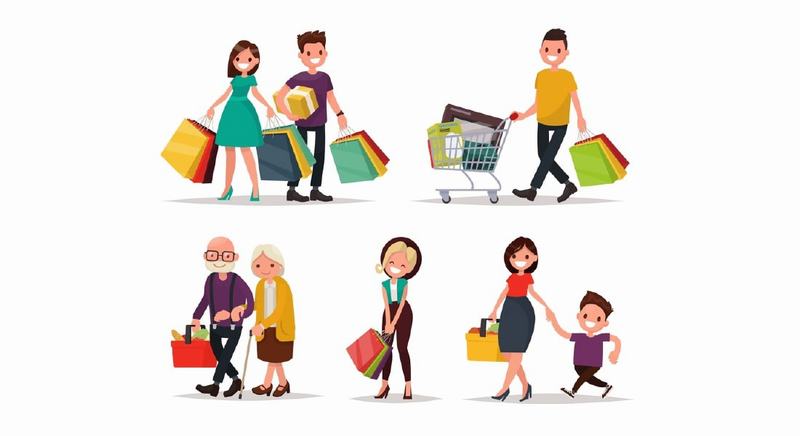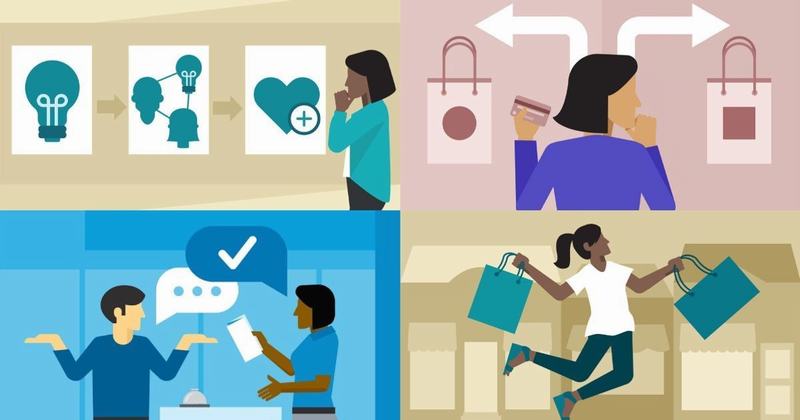We will explore post-purchase customer behavior such as product reviews, returns, product warranties, and post-purchase interactions with businesses. Understanding post-purchase customer behavior will help businesses understand customers’ needs and desires, thereby providing the best after-sales service to build trust and maintain long-term relationships with customers. In this article, we will learn about post-purchase customer behavior, including its definition, role, and classification.
What is post-purchase customer behavior?
Post-purchase customer behavior or post-purchase customer behavior includes the thoughts, feelings, and actions of customers after experiencing a product or service.
This stage plays a crucial role in determining their loyalty to the brand. It is also a golden opportunity for businesses to collect feedback, improve the experience and stimulate future purchases for customers.

Post-purchase behavior is the customer’s emotions and actions after experiencing the product.
Why is it important to understand post-purchase customer behavior?
Understanding post-purchase behavior is the way for brands to bring the best feelings and shopping experiences to their customers. By implementing effective post-purchase marketing, brands can:
Customer retention
Customers who have a positive experience are more likely to return to purchase or recommend the product to friends and family. Conversely, a negative experience can lead to customer loss, damage brand reputation, and create opportunities for competitors. Therefore, businesses need to understand post-purchase customer behavior to improve customer retention.
Brand reputation
Satisfied customers are 67% more likely to make a purchase and 52% more likely to recommend your brand to a friend. This increases revenue, saves money, and strengthens your brand reputation. On the other hand, dissatisfied customers can leave negative reviews, damaging your reputation and driving away potential customers.
Measure demographic data effectively
Measuring post-purchase customer behavior provides businesses with essential insights into customer preferences, needs, and pain points. By understanding customer needs, businesses can better develop products and services that meet customer needs.
How to understand post-purchase customer behavior?
Businesses can use a variety of methods to measure customer satisfaction, ranging from product reviews and surveys to loyalty program memberships.
However, the best way to proactively track post-purchase customer behavior is to use return tracking and analytics software. Businesses can view detailed data on sales management software such as:
- Returned product code
- Number of returned items
- Return processing costs

Customer satisfaction with products brings many business benefits.
What are the post-purchase customer actions?
After making a purchase, customers will have certain actions and thoughts, called post-purchase behavior. This is the process by which customers continue to interact with the product or service after completing the purchase transaction. So after making a purchase, what actions do customers have?
Public action
When customers are dissatisfied, they can take public actions such as:
- Customers complain directly to the business
- Seek legal assistance
- Complain to other organizations such as businesses, private individuals or government agencies.
- Share negative feedback on online forums
Post-purchase customer behavior is intended to let the company know about customer dissatisfaction and can resolve the issue promptly. They can also negatively impact the company’s reputation and image if not handled effectively.
Post-purchase customer behavior is not public
In addition to overt actions, dissatisfied consumers may also take covert actions such as:
- Exit option: The decision to stop purchasing a company’s products or services.
- Voice option: Share negative feedback or “warn” others about negative experiences with a product or service.
Customer product usage and abandonment behavior
In addition to tracking post-purchase customer behavior, marketers should also learn about their product usage and abandonment behavior. Some common post-purchase product actions by customers include:
- Temporary product abandonment: Rent – Lend.
- Permanently Discard Products: Give Away – Trade – Sell – Throw Away
- Retain: Use for original purpose – Use for another purpose – Store
After purchase, what should businesses do to retain customers?
In addition to understanding post-purchase customer behavior, businesses need to implement some post-purchase marketing to retain them. Each method will depend on the business industry, product/service and target customer group. Below are 9 popular and effective ways to retain customers.
Refund Policy
To improve the shopping experience and retain customers, sending emails about refund policies when they are not satisfied with the product is an effective solution. The email content should clearly state the conditions, process and refund period for customers to understand.
For example, online shoe retailer Zappos has a generous return policy that allows customers to return products within 365 days without any reason. This policy has helped Zappos build a reputation for excellent customer service and attract a large, loyal customer base.

Refund policy is an effective post-purchase marketing method.
Return Policy
After the sale, brands should have a return policy in place if customers are not satisfied with the product. By proactively providing detailed information about the return process, marketers can help customers understand their rights and build a brand image that leads to more positive post-purchase customer behavior.
For example:
There was a case of a customer who purchased a pair of running shoes from REI (Recreational Equipment, Inc.), a US outdoor and sporting goods retailer. After a few weeks of use, he found the shoes uncomfortable and painful, so he returned them to an REI store. Even though the shoes had been used, the store staff accepted the return without asking for a receipt because the transaction was recorded in REI’s membership system.
As a result, the customer opted to exchange the shoes for another pair, continue shopping at REI, and feel secure with the flexible return policy. The customer was so pleased with REI’s customer service that he shared his positive experience on review sites like Yelp and forums like Reddit.
User Manual
To provide the best consumer experience, brands should provide detailed instructions on how to use and preserve the product. Marketers can use infographics, instructional videos or provide useful information on the business website.
For example, IKEA is known for its detailed, easy-to-understand instructions, using 3D illustrations to help customers assemble furniture easily. As a result, the brand has reduced returns due to assembly errors and increased customer satisfaction with the shopping and product experience.
About related products
Based on previous purchase history and product searches, brands can use clever “tactics” to recommend personalized products that are relevant to customers. This helps retain customers for the brand as well as increase their likelihood of repurchasing the business’s products.
For example, Nike first introduced the Nike Air Max line of shoes with special air technology to improve comfort and performance. They then expanded the line with other versions such as the Air Max 90, Air Max 95, and Air Max 97, each with different improvements and designs but still keeping the core air technology.
The introduction of these related products has helped increase sales, strengthen the brand, and attract a large number of loyal customers for NIKE. The continuous launch of new versions not only diversifies the product but also maintains Nike’s leading position in athletic shoe technology.
Loyalty program
By implementing preferential pricing policies, exclusive offers and attractive reward points redemption programs, businesses can attract customers to return for a second purchase, thereby increasing customer retention rates and strengthening brand loyalty.
For example, Starbucks Rewards is a successful loyalty program for the coffee chain Starbucks. It has attracted millions of members and offers many benefits to both Starbucks and its customers. Customers who join the Rewards program shop at Starbucks more often and spend more money per purchase.

User manuals help customers better understand your products.
Invite customers to give feedback on product satisfaction
Brands collect customer feedback on their satisfaction with products and services. This brings many practical benefits, helping businesses:
- Understanding customer product experience
- Improve the quality of services and products in the best way
- Demonstrates brand concern for customers
For example, low-cost airline AirAsia has an “AirAsia Voice” program that encourages customers to share feedback about their experiences through emails, online surveys, and social media. Thanks to this program, AirAsia has made many positive changes such as improving the check-in process, upgrading seats, and enhancing customer service.
Encourage customers to refer products to friends
Businesses take advantage of customer satisfaction to encourage them to introduce products to friends and relatives. Bringing many benefits such as: increasing brand awareness, saving marketing costs, increasing conversion rates and increasing customer loyalty.
For example, Airbnb is a globally popular home-sharing platform that has become wildly successful thanks to its unique business model and smart marketing strategy. One of the key factors contributing to Airbnb’s success is its referral program.
In this program, when a user refers Airbnb to a new person and that person makes a first-time booking, both of them can receive a discount on their next booking. This not only motivates existing customers to share their positive experiences with their friends, but also helps Airbnb expand its customer base effectively.
Communicate on social media and encourage user-generated content
To attract attention and engagement from potential customers, brands should make the most of the power of social media. One effective way to do this is to encourage user-generated content (UGC) through hashtag campaigns and contests. UGC provides brands with authentic customer reviews, which helps build trust and attract new customers.
For example, GoPro often runs contests like “Photo of the Day” or “Video of the Week” that encourage users to submit content for a chance to be featured on the air or win prizes. The best content from these contests is often shared widely across GoPro’s social media platforms and other channels, creating virality for the brand.
Additional reminders
Marketers should apply a smart strategy of sending email reminders to customers to re-order products, ensuring reasonable frequency. This helps maintain the brand’s presence in the customer’s mind and stimulates the need for further purchases. At the same time, it minimizes the possibility of them being attracted by competitors’ promotions.
For example, Sephora, a popular cosmetics and fragrance retailer, has successfully implemented a follow-up reminder strategy to drive sales and increase customer retention. Some of the tactics Sephora uses include: sending abandoned cart reminder emails, sending related product emails, sending promotional and discount emails, etc.
In this article, we have provided readers with effective ways to retain customers. It is important to remember that post-purchase customer behavior is always changing, so businesses need to adjust their marketing strategies accordingly.
Comment Policy: We truly value your comments and appreciate the time you take to share your thoughts and feedback with us.
Note: Comments that are identified as spam or purely promotional will be removed.
To enhance your commenting experience, consider creating a Gravatar account. By adding an avatar and using the same e-mail here, your comments will feature a unique and recognizable avatar, making it easier for other members to identify you.
Please use a valid e-mail address so you can receive notifications when your comments receive replies.